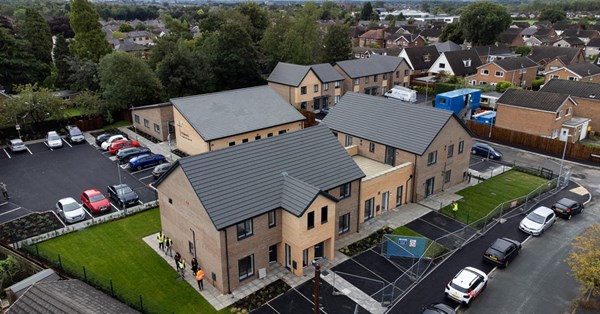CHURCHES hoping to build affordable homes for their communities on pockets of land that they own — or as part of schemes such as rebuilding parish halls — have been invited to apply for grants to pay for expert advice from a £3.2-million fund from the Archbishops’ Council.
The fund will run for five years. Grants of up to £25,000 are available towards the cost of an architect, consultant, and other professional fees needed to assess the feasibility of housing proposals on church land. Grants can also be made to help meet the cost of navigating the planning process.
The fund follows the publication, in 2021, of the Archbishops’ Commission on Housing, Church and Community, Coming Home (News, 26 February 2021), which concluded that the Church had a “major role” to play in addressing the the nation’s housing needs, “ensuring that our land and resources are used for the blessing of all, and not only seen as potential financial assets for our own benefit”. It encouraged both dioceses and parishes to “become more deeply involved”.
The barriers for parishes concerned constraints of time, lack of specialist skills and anxieties about the risks involved, it said. Since publication, a Housing Project team has been established at Church House, led by Beki Winter, formerly of the charity Housing Justice.
“Many parishes have issues with their buildings or property, but don’t always realise that these problems could be opportunities to provide some housing,” Ms Winter said last week. “An outdated church hall could be rebuilt to include a few flats above it, or a surplus car park could be redeveloped to provide some social homes. There are many creative ways to use church land or property to provide housing for people in need, whilst improving community facilities or bolstering parish finances.”
A grant has already been made to Emmanuel, Preston, a Grade II listed building that is no longer safe for worship. The congregation has been worshipping in the neighbouring community centre. The aim now is to create affordable housing on the church site, through the creation of a Community Land Trust to which the diocese will transfer the assets and in partnership with a local ethical developer. The use of a listed building for affordable housing in the Church of England was “treading new ground”, Ms Winter said on Tuesday. “If they can do it there, it opens the door for other opportunities.”
In Chorley, a congregation had been told that an unlisted church built with porous stone would cost £750,000 to be made watertight, leaving structural issues in place. The housing team was now working with them to investigate whether the church could be dismantled and a new church built on it, with affordable housing built on the neighbouring field. Meanwhile, a 60-year-old parish-hall site at St Martin’s, Fulwood, in Preston, has already been developed into 14 affordable homes and a new energy-efficient parish centre.
Collectively, the Church of England holds approximately 200,000 acres of land. Much diocesan land is “glebe”, currently required by law to be held to fund clergy stipends. Many local parish churches also hold land in their own right. The Coming Home report noted that the development of housing or other uses of land or properties could cause controversy, “exacerbated by the interpretation and application of charity law”. The requirement to secure the “best terms reasonable obtainable” was usually interpreted as “best price”. This, it said, “risks the perception that the Church does not care about its communities and is more interested in money than mission”.
While noting the “enormous” financial pressures faced by dioceses, it argued that the sale of land or assets by dioceses to sustain current patterns of ministry was not “the best way to use our resources properly. . . For stewardship to be exercised responsibly it must clearly benefit the whole created order and not just be geared towards the preservation of the institution.”
The view of the legal office of the National Church Institutions is that PCCs are already able to sell land at less than full value: for example, to meet local community need, provided that the land was not held on trust for purposes which precluded it being used in this way. Guidance for PCCs, Faith in Affordable Housing, commissioned by Housing Justice, is available online. A mapping tool for dioceses showing all church-owned land and buildings in England is currently being upgraded.
On Tuesday, Ms Winter said that the fund would help churches to work out what was feasible. “Ultimately it is still down to PCCs to make sure they are meeting their charitable objectives. If a hall is worth say £500,000 on the market but for an affordable housing scheme it would achieve significantly less, then the PCC needs to consider what’s most important to them from a missional perspective and what other demands are on their finances.”
The success of the fund would not be illustrated by how many houses were built — given the timeframe involved — but the number of applications and generation of best practice and case studies, she said.
In 2021, the General Synod resolved that responding to housing need was “an integral part of the mission and ministry of the Church of England” (News, 16 July 2021). In response to the Coming Home recommendation that the Archbishops’ Council bring legislation to the Synod enabling dioceses to dispose of glebe assets “for appropriate missional purposes other than solely, as currently, for ministry costs”, the Synod’s motion requested that the Archbishops’ Council “consider the need for change to the legal criteria for the management, use and disposal of Church held non-operational property that falls under the remit of the Church Property Measure and Mission and Pastoral Measure”. To date, nothing has been brought back to the Synod.
Last year, the Church Housing Association and Church Development Agency were set up to work on speeding up the delivery of affordable homes, mainly on diocesan and parish land (News, 29 November 2024).

















